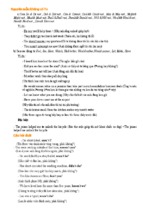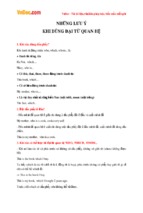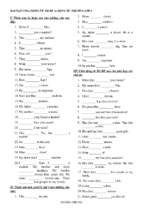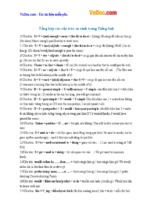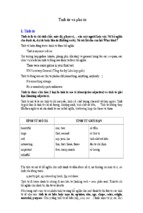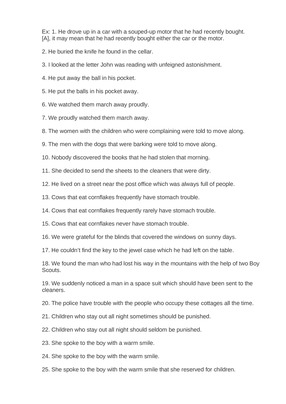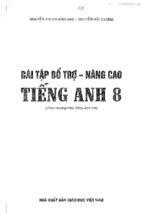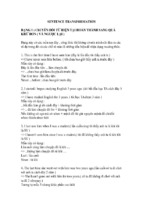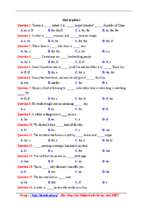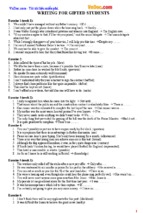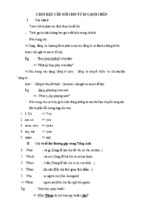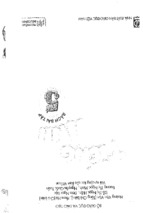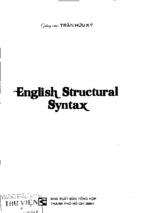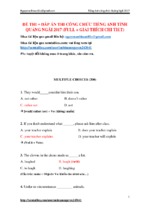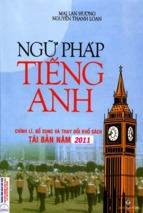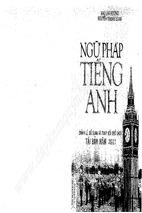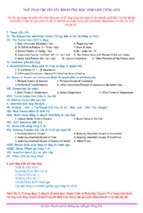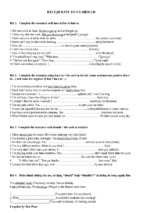thanh ngu tieng anh thong dung
CONDITIONAL EXERCISES
Summarise the information by selecting and reporting the main features,
and make comparisons where relevant.
Write at least 150 words
Task 1 plan:
Introduction: paraphrase task heading
summary paragraph – 2 major features
changes in the percentages for the different sectors during the period
while the figures for food and beverages and also video games increased, the
figures for the other two sectors fell
paragraph 3 – detail for the sectors with increased percentages
paragraph 4 – detail for the sectors with reduced percentages
Model sample:
The charts compare four retail sectors in Canada in terms of the proportion of their
internet sales in two years, 2005 and 2010.
Overall, the proportion of online sales for each of the four sectors changed significantly
from 2005 to 2010. While the figures for food and beverages and also video games
increased, the figures for the other two sectors fell.
In 2005, the proportion of online sales of food and beverages was 22%, but this rose to
32% in 2010. The percentage for internet sales of video games also went up, by 5% from
the 2005 figure of 18%.
In contrast, the percentages of the online sales of the other sectors decreased. The most
dramatic fall was in the home furnishings retail sector. While this figure was 25% of the
total online sales of these four sectors in 2005, it fell to just 15% in 2010. There was also a
decrease in the electronics and appliances sector, which saw a fall from 35% in 2005 to
30% in 2010.
(170 words)
IELTS Academic Writing Task 1. Sample 1
The pie graphs below show the result of a survey of children's activities. The first graph shows the
cultural and leisure activities that boys participate in, whereas the second graph shows the
activities in which the girls participate.
Write a report describing the information shown in the two pie graphs.
Write at least 150 words.
Model answer
The two pie charts draw the conclusion of a survey of boys' and girls' cultural and leisure
activities.
Overall, equal quantities of both sexes enjoyed listening to music, but a dramatically larger
number of girls liked reading. There were also many differences in terms of the children's
preferred sports.
Turning to the first chart, we can observe that boys prefer playing computer games (34%
participation rate) than taking other activities. Playing basketball comes as the second most
popular leisure, practiced by almost a third of male children. Basketball is followed by soccer,
which is exercised by 17%. Skateboarding and listening to music are less preferable activities,
chosen by 11% and 10% of boys respectively. Reading, the least popular cultural activity among
boys, represents only two percent.
Taking a closer look at the second chart, we can see that girls' most preferred activity is
dancing, being 27% of the total. In contrast to the boys' preferences, reading is chosen by more
than a fifth of all girls. Although percentage of female children who play computer games is
roughly twice less than that of boys (16%), this activity is third most popular on the girls' chart.
With a slight difference between computer games and netball, the latter is practiced at 15%
rate. Similarly to skateboarding popularity among boys, 11% of girls go in for gymnastics.
Listening to music comes as the least popular leisure, with a proportion of 10%, equal to those
on the first chart.
You should spend about 20 minutes on this task.
Write a report for a university lecturer describing the information in the graphs below.
Write at least 150 words.
Your task
Complete the task one report writing exercise above. Spend only 20 minutes. Then look at the guidelines and the sample
answer below.
Sample answer 1
The pie charts compare the highest level of education achieved by women in Someland across two years, 1945 and 1995.
It can be clearly seen that women received a much higher level of education in Someland in 1995 than they did in 1945.
In 1945 only 30% of women completed their secondary education and 1% went on to a first degree. No women had
completed post-graduate studies. This situation had changed radically by 1995. In 1995, 90% of women in Someland had
completed secondary education and of those, half had graduated from an initial degree and 20% had gone on to
postgraduate studies. At the other end of the scale we can see that by 1995 all girls were completing lower secondary,
although 10% ended their schooling at this point. This is in stark contrast with 1945 when only 30% of girls completed
primary school, 35% had no schooling at all and 35% only completed the third grade.
In conclusion, we can see that in the 50 years from 1945 to 1995 there have been huge positive developments to the
education levels of women in Someland.
Pie Charts normally illustrate proportion
Pie Charts normally show proportion, which can be measured in percentages or fractions.
This chart shows the relative size of populations of countries of the European Union in 2007. So we can only
make comparisons; we cannot say anything about change.
We can see that the country with the largest population was Germany with 16.6% of the European Union's
population. We can also see that the second largest population was that of France with 12.8% of the
population.
We do NOT know from this chart which country has the smallest population because the 21 smallest countries
are included in one group. (If you're interested, it is Malta with less than 0.1 per cent.)
You can see that the four largest countries (Germany, France, the United Kingdom and Italy) together make up
more than half of the European Union's population.
You CANNOT say that Poland has the smallest population: 21 other countries have populations smaller than
Poland's.
The twenty-one smallest countries of the European Union make up nearly 30% of the population.
This chart shows the relative size of populations of countries of the European Union in both 1998 and 2007. In this
case we can make two sets of comparisons:
1.
2.
We can make comparisons between the countries in each year.
We can make comparisons between the two years (i.e. examine any changes from 1998 to
2007).
In this case, we’ll look at comparisons between the two years.
The first thing to notice is that there is very little change: all changes amount to less than 1%.
The second change to notice is which countries’ populations grew (as a proportion of the whole) and which
countries’ populations shrank.
You can see that both Germany’s and Poland’s populations share of the European Union’s Population fell from 1998
to 2007 ( from 17.1% to 16.6 % and from 8% to 7.7%, respectively).
The percentage populations of the other major countries of the European Union grew in this period. The largest
growth in population share was that of Spain which increased its share from 8.3% to 9%. Both the UK’s and Italy’s
share of the EU population grew by only 0.1%.
In spite of the change in Germany’s population share, it remained the largest population of the European Union.
Note that you CANNOT say that Germany’s population fell or that France’s population grew. These charts only show
population share, not population numbers.
Pie Chart Graphics
The students will describe the graphic assigned to that student to the other students.
Look at the pie chart, exam question and sample answer and do the exercises to improve your writing skills.
Instructions
13
Preparation
105 thành ngữ thông dụng trong Tiếng Anh
Trong quá trình học Tiếng Anh giao tiếp thông dụng, đôi khi chúng ta quá chú ý đến phát âm, từ vựng mà bỏ
quên thành ngữ Tiếng Anh. Thành ngữ thường được sử dụng trong văn nói và đem lại hiệu quả giao tiếp mà bạn
không thể ngờ đến.
Sử dụng thành ngữ giúp ngôn từ của bạn trở nên tự nhiên, sinh động như người bản xứ. Dưới đây VnDoc xin
giới thiệu đến các bạn những Thành ngữ Tiếng Anh để áp dụng trong Tiếng Anh giao tiếp thông dụng hàng
ngày.
1. Break the news: Thông báo
Ex: They are getting married. They have just broken the news to their friends.
2. Cost an arm and a leg: Rất đắt
Ex: In the future, the robot will not cost an arm and a leg.
3. Give someone the ax: Đuổi việc ai đó
Ex: The boss give me the ax.
4. Real flop: Thất bại
5. When pigs fly: Chỉ điều gì đó khó mà xảy ra được
Ex:
A: Maybe she will change her mind. We are getting back together.
B: When pigs fly! She have another man.
6. Look on the bright side: Hãy lạc quan lên
Ex:
A: I failed the exam again. Maybe I will never pass it.
B. Look on the bright side. If you study hard enough, you will pass the exam.
7. Easier said than done: Nói dễ hơn làm
Ex: Starting your own business is easier said than done.
8. Drive one crazy: Làm phiền ai đó rất nhiều
Ex: Please turn down the radio. It’s driving me crazy.
9. Take it easy: Đừng lo lắng, thư giãn nào
10. Go into business: Bắt đầu công việc kinh doanh
11. In a bad mood: Không vui
Ex: After breaking up with her boy friend, she was in a bad mood for several days.
12. Out of the world: Ngon
Ex: Your roasted duck is out of the world.
13. Give it a shot: Thử cái gì đó
Ex: I’ve never traveled alone before, but perhaps I’ll give it a shot.
14. Work like a dog: Làm việc rất chăm chỉ
Ex:
A: Jane works 6 days a week.
B: Really? She works like a dog.
15. Beat around the bush: Nói vòng vo tam quốc
Ex: Stop beating around the bush. What do you want from me?
16. Good for you: Làm tốt lắm
Good for you = Good job = Well done
17. In good spirits: Hạnh phúc, tâm trạng tốt
Ex: He won three gold medals. Now he is in good spirits.
18. You scratch my back and I’ll scratch yours: Nếu cậu giúp tôi thì tôi sẽ giúp lại cậu
Ex: If you do my Math homework, I’ll give you her phone number. You scratch my back and I’ll scratch
yours.
19. Make a pig of oneself: Ăn quá nhiều
20. You can say that again: Tôi đồng ý với bạn
Ex: You think Bob is a good leader? You can say that again. His team always win.
Trên đây là các thành ngữ chúng tôi đưa kèm ví dụ để các bạn dễ hiểu, mời các bạn tham khảo thêm các thành
ngữ bên dưới và tự đặt ví dụ cho quá trình học tập của mình hiệu quả hơn!
21. Easy come, easy go: Của thiên trả địa.
22. Seeing is believing: Tai nghe không bằng mắt thấy.
23. Easier said than done: Nói dễ, làm khó.
24. One swallow does not make a summer: Một con én không làm nên mùa xuân.
25. Time and tide wait for no man: Thời giờ thấm thoát thoi đưa, nó đi di mãi có chờ đại ai.
26. Grasp all, lose all: Tham thì thâm
27. Let bygones be bygones: Hãy để cho quá khứ lùi vào dĩ vãng.
28. Hand some is as handsome does: Cái nết đánh chết cái đẹp.
29. When in Rome, do as the Romes does: Nhập gia tuỳ tục
30. Clothes does not make a man: Manh áo không làm nên thầy tu.
31. Don't count your chickens, before they are hatch: chưa đỗ ông Nghè đã đe Hàng tổng
32. A good name is better than riches: Tốt danh hơn lành áo
33. Call a spade a spade: Nói gần nói xa chẳng qua nói thật
34. Beggar's bags are bottomless: Lòng tham không đáy
35. Cut your coat according your clothes: Liệu cơm gắp mắm
36. Bad news has wings: Tiếng dữ đồn xa
37. Doing nothing is doing ill: Nhàn cư vi bất thiện
38. A miss is as good as a mile: Sai một li đi một dặm
39. Empty vessels make a greatest sound: Thùng rỗng kêu to
40. A good name is sooner lost than won: Mua danh ba vạn, bán danh ba đồng
41. A friend in need is a friend indeed: Gian nam mới hiểu bạn bè
42. Each bird loves to hear himself sing: Mèo khen mèo dài đuôi
43. Habit cures habit: Lấy độc trị độc
44. Honesty is best policy: Thật thà là cha quỷ quái
45. Great minds think alike: Tư tưởng lớn gặp nhau
46. Go while the going is good: Hãy chớp lấy thời cơ
47. Fire is a good servant but a bad master: Đừng đùa với lửa
48. The grass is always greener on the other side of the fence: Đứng núi này trông núi nọ
49. A picture is worth a thousand words: Nói có sách, mách có chứng
50. Actions speak louder than words: Làm hay hơn nói
51. One good turn deserves another: Ở hiền gặp lành
52. He who laughs today may weep tomorrow: Cười người chớ vội cười lâu. Cười người hôm trước hôm sau
người cười.
53. Man proposes, God disposes: Mưu sự tại nhân, thành sự tại thiên
54. A rolling stone gathers no moss: Nhất nghệ tinh, nhất thân vinh/Trăm hay không bằng tay quen
55. A miss is as good as a mile: Sai một ly đi một dặm
56. A flow will have an ebb: Sông có khúc người có lúc
57. Diligence is the mother of good fortune: Có công mài sắt có ngày nên kim
58. You scratch my back and i’ll scratch yours: Có qua có lại mới toại lòng nhau
59. Grasp all, lose all: Tham thì thâm
60. A blessing in disguise: Trong cái rủi có cái may
61. Where there’s life, there’s hope: Còn nước còn tát
62. Birds of a feather flock together: Ngưu tầm ngưu, mã tầm mã
63. Necessity is the mother of invention: Cái khó ló cái khôn
64. One scabby sheep is enough to spoil the whole flock: Con sâu làm rầu nồi canh
65. Together we can change the world: Một cây làm chẳng nên non, ba cây chụm lại nên hòn núi cao
66. Send the fox to mind the geese: Giao trứng cho ác
67. As poor as a church mouse: Nghèo rớt mồng tơi
68. A bad begining makes a good ending: Đầu xuôi, đuôi lọt
69. There’s no smoke without fire: Không có lửa sao có khói
70. Love me, love my dog: Yêu nhau yêu cả đường đi, ghét nhau ghét cả tông ti họ hàng
71. It is the first step that costs:Vạn sự khởi đầu nan
72. A friend in need is a friend indeed: Gian nan mới hiểu lòng người
73. Rats desert a falling house: Cháy nhà mới ra mặt chuột
74. Tit For Tat: Ăn miếng trả miếng
75. New one in, old one out: Có mới, nới cũ
76. Make hay while the sun shines: Việc hôm nay chớ để ngày mai
77. Handsome is as handsome does: Tốt gỗ hơn tốt nước sơn
78. Bitter pills may have blessed effects: Thuốc đắng dã tật
79. Blood is thicker than water: Một giọt máu đào hơn ao nước lã
80. An eye for an eye, a tooth for a tooth: Ăn miếng trả miếng
81. A clean hand wants no washing: Cây ngay không sợ chết đứng
82. Neck or nothing: Không vào hang cọp sao bắt được cọp con
83. Cleanliness is next to godliness: Nhà sạch thì mát, bát sạch ngon cơm
84 Cut your coat according to your cloth: Liệu cơm gắp mắm
85. Never say die: Chớ thấy sóng cả mà ngã tay chèo
86. Constant dripping wears away stone: Nước chảy đá mòn
87. Men make houses, women make homes: Đàn ông xây nhà, đàn bà xây tổ ấm
88. The proof of the pudding is in the eating: Đường dài mới biết ngựa hay
89. So many men, so many minds: Chín người, mười ý
90. Fine words butter no parsnips: Có thực mới vực được đạo
91. Too many cooks spoil the broth: Lắm thầy nhiều ma
92. Carry coals to Newcastle: Chở củi về rừng
93. Nothing ventured, nothing gained: Phi thương bất phú
94. Still waters run deep: Tẩm ngẩm tầm ngầm mà đấm chết voi
95. Make your enemy your friend: Hóa thù thành bạn
96. Stronger by rice, daring by money: Mạnh vì gạo, bạo vì tiền
97. Words must be weighed, not counted: Uốn lưỡi bảy lần trước khi nói
98. Fire proves gold, adversity proves men: Lửa thử vàng, gian nan thử sức
99. Live on the fat of the land: Ngồi mát ăn bát vàng
99. Empty vessels make the most sound: Thùng rỗng kêu to
100. Words are but Wind: Lời nói gió bay
101. Make a mountain out of a molehill: Việc bé xé to
102. When the blood sheds, the heart aches: Máu chảy, ruột mềm
103. Every Jack has his Jill: Nồi nào vung nấy/Ngưu tầm ngưu, mã tầm mã/Rau nào sâu nấy
104. More haste, less speed: Dục tốc bất đạt
105. Speech is silver, but silence is golden: Lời nói là bạc, im lặng là vàng
- Xem thêm -

